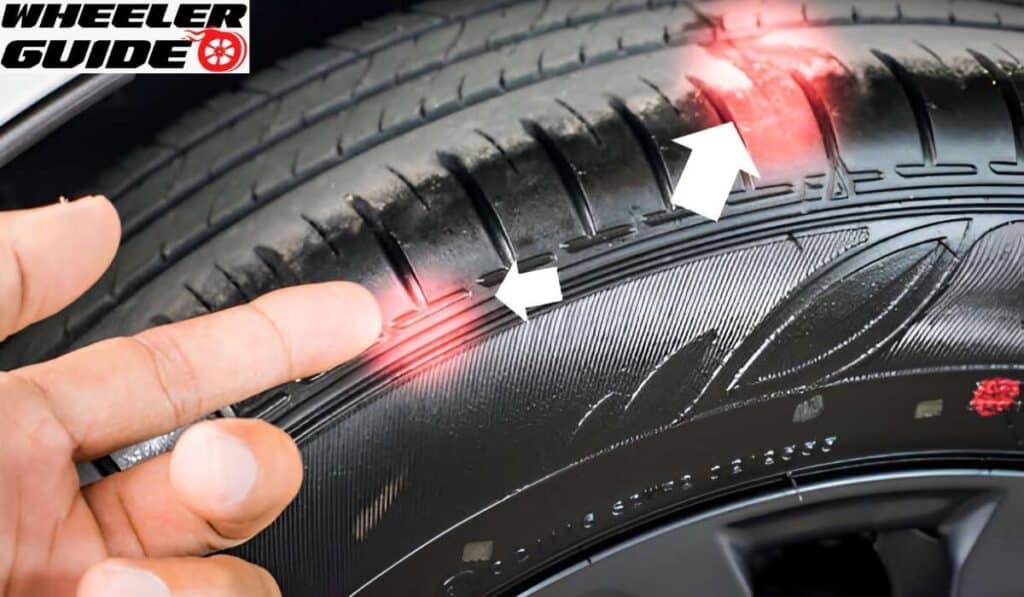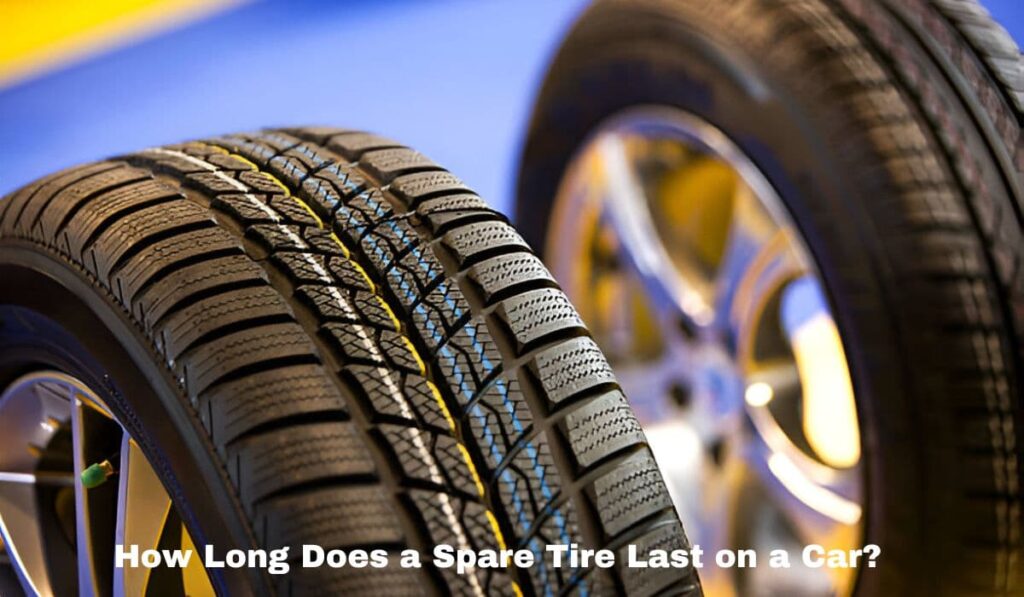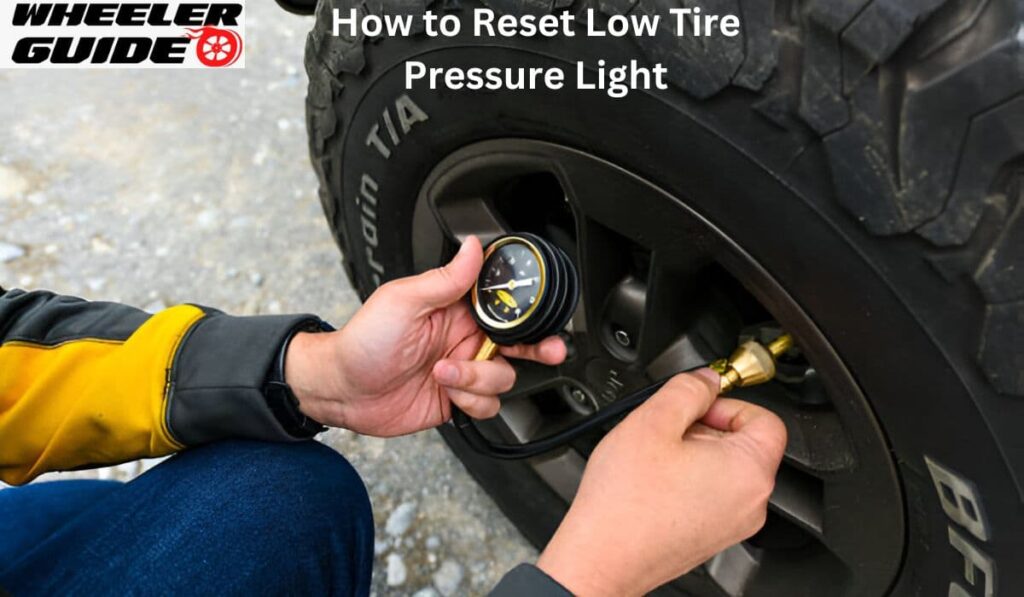Tire pressure issues can be a frustrating problem for many drivers. You might notice your low tire pressure light coming on more often or find yourself constantly adding air to your tires. This not only takes up your time but can also affect your vehicle’s performance and safety.
Low tire pressure can lead to handling problems, tire damage, and even dangerous driving conditions. Understanding why your tires keep losing air is the first step to fixing the issue. There are several possible causes, from normal air loss and weather changes to problems with your wheel, tire valve, or the tire itself. By learning about these causes and their solutions, you can keep your tires properly inflated and ensure a safer, smoother ride.
Why do tires gradually lose air?
Regular air seepage
Tires naturally lose a small amount of air over time. You might notice your tires losing about 5-10% of their pressure each month. This is why it’s important to check your tire pressure regularly. Keep a tire pressure gauge at home and use it often to stay on top of any changes.

Temperature shifts
The air in your tires responds to temperature changes. When it gets colder, tire pressure drops. For every 18°F decrease in temperature, you can expect a 3-4% drop in tire pressure. The opposite happens when it gets warmer – pressure increases by about 3-4% for every 18°F rise in temperature.
This effect is most noticeable during seasonal changes, especially as winter weather approaches. Don’t be alarmed if you find your tires slightly underinflated on a cold morning. As the day warms up, the pressure will often return to normal by the afternoon.
If temperatures stay low for a long time, you might need to add air. But for daily temperature swings, it’s usually not necessary. The air in your tires expands when heated and shrinks when cooled, but the amount of air stays the same.
Be cautious if your tire pressure drops more than 25% below the recommended level. This can be dangerous and triples your risk of a tire-related accident. Your tire pressure monitoring system will typically alert you at this point.
To stay safe:
- Check your tire pressure regularly
- Pay attention to seasonal temperature changes
- Don’t rush to add air on cold mornings
- Address significant pressure drops promptly
Remember, maintaining proper tire pressure is key to your safety on the road. It also helps your tires last longer and improves your vehicle’s fuel efficiency.
Tire and Wheel Valve Issues
Damage or Corrosion on Wheels
Your wheels can face problems over time. Aluminum wheels may rust, especially when exposed to salt or water. This rust can damage the wheel’s surface, causing a poor fit with the tire and leading to air loss.
Road hazards like potholes can also harm your wheels. If a wheel loses its round shape, it won’t fit the tire well. This can cause air to leak out slowly.
Leaky Tire Valves
Tire valves are key for keeping air in your tires. But they can weaken or get damaged. A bad valve can let air escape, causing your tire to lose pressure bit by bit.
Check your valves often to catch leaks early. They should last as long as your tires, but if you see air loss of more than 1-3 psi per month, you might need new ones.
Be careful not to tighten valves too much, as this can harm them. Also, chemicals in your garage or on the road can damage valves over time.
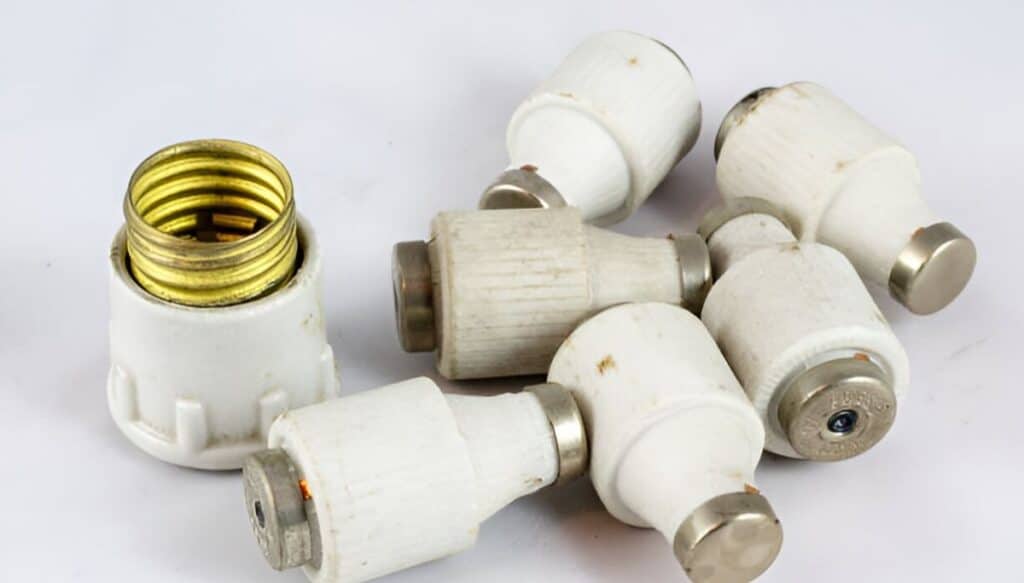
Absent Valve Caps
A missing valve cap is easy to fix, but don’t wait too long. Valve caps protect the valve from dirt and water. They also guard against direct damage.
Without a cap, your valve can leak or get dirty inside. This might seem small, but it can cause big problems. If you’re missing a cap, buy a new one soon.
To keep your tires in good shape:
- Check tire pressure monthly
- Look for signs of wheel damage
- Clean your wheels regularly
- Replace valve caps if lost
- Have a pro check your valves yearly
By taking care of these parts, you can avoid many tire air loss issues.
Wheel and Rubber Woes
Damaged Treads and Sidewalls
Your tires face constant challenges on the road. Potholes, sharp objects, and everyday wear can harm them, leading to air loss. Check your tires often to catch problems early.
A common issue is punctures. Nails, glass, or other sharp items can pierce your tire. This can cause slow leaks, with air escaping at 2-3 psi daily. Even if a nail stays in the tire, it needs removal. Ignoring it may worsen the leak and require urgent fixes.
Hitting curbs or large potholes can also cause air loss. The impact flexes tire sidewalls. If you don’t see damage, re-inflating might solve it. But look for:
- Sidewall bulges
- Cuts
- Punctures
These signs point to internal or external harm that could cause leaks.
Rim Seal Issues
The area where your tire meets the rim is crucial. It forms an airtight seal. But this seal can break, causing slow leaks. Reasons include:
- Rim corrosion
- Trapped debris
- Damage to the tire edge
Check this area if you notice steady air loss.
Age-Related Cracking
Time isn’t kind to tires. Sun and weather break down rubber over time. This leads to cracks, known as dry rot. Signs include:
- Visible cracks on the tire surface
- Brittle rubber
- Faded color
Dry rot can cause slow leaks and tire failure. It’s vital to know your tire’s age before buying. Replace old tires, even if they look fine on the surface.
To keep your tires in top shape:
- Inspect them monthly
- Clean the rim and tire edge regularly
- Store spare tires properly
- Rotate tires as recommended
By caring for your tires, you’ll avoid many common air loss issues. This helps keep you safe on the road and saves money on early replacements.

How to Handle Tire Air Loss
Finding the Air Escape
When your tires are losing air, you need to locate the source. Here are two effective methods:
- Soapy Water Technique:
- Mix soap or detergent with water in a spray bottle
- Spray the solution on:
- Valve stem
- Rim edges (inside and outside)
- Tire sidewalls and tread
- Watch for bubbles forming (may take up to 5 minutes)
- Water Immersion Method:
- Remove the wheel from your vehicle
- Submerge it in water
- Look for small bubbles rising (allow 5 minutes)
- Flip the tire if no bubbles appear initially
The soapy water method is usually quicker and doesn’t require removing the tire.
Addressing Tire Air Leaks
When you’ve found the leak, you have several options:
- Fix the tire
- Repair the valve stem
- Address rim issues
Keep in mind that some damage may be beyond repair. Temporary fixes should only be used to get you to a tire shop safely.
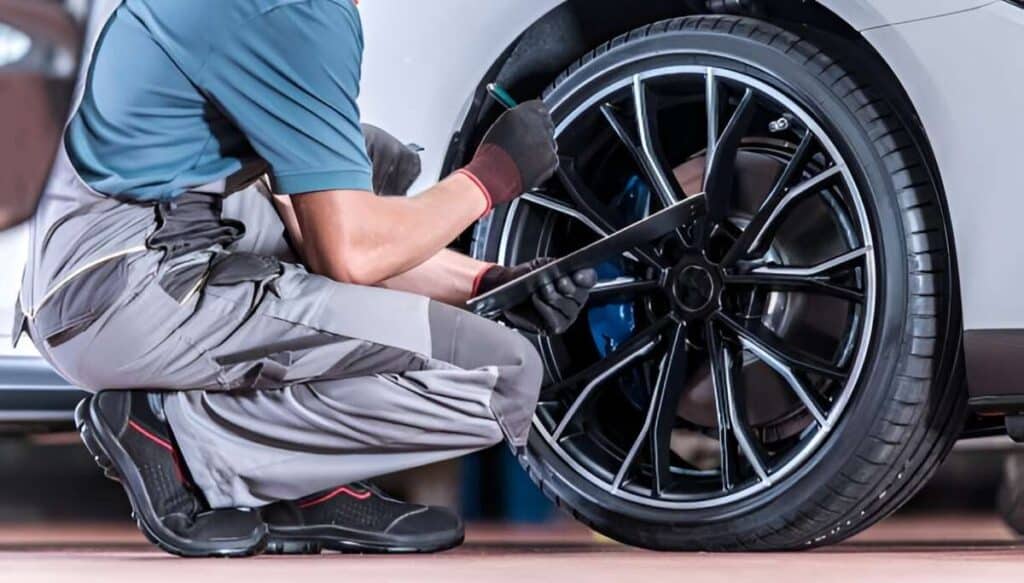
Mending a Tire
For DIY repairs, use a plug kit on tread punctures only. This is a temporary fix!
Plug Kit Contents:
- Plugs
- Rubber cement
- Reaming tool
- Plug tool
You’ll also need pliers to remove any objects from the tire.
Steps to plug a tire:
- Remove the puncturing object
- Clean the hole with the reaming tool
- Insert the plug into the plug tool
- Apply rubber cement to the plug tip
- Push the plug into the hole
- Trim excess plug material
- Inflate the tire once dry
Warning: Never plug sidewall damage. This can lead to dangerous blowouts.
After plugging, drive to a tire shop as soon as possible for a professional assessment.
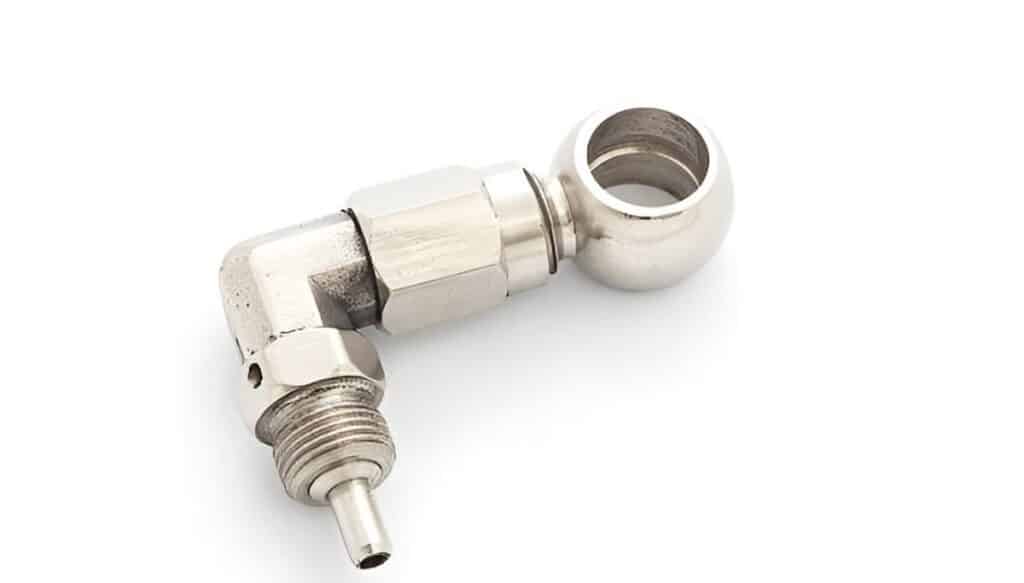
Fixing the Valve Stem
If your valve stem is the culprit, you can replace it yourself:
Tools needed:
- Valve removal tool
- New valve core
- A car jack and lug wrench (optional)
Steps:
- Remove the old valve core
- Clean the stem if corroded
- Install the new core
- Reinflate the tire
Always wear safety glasses during this process.
Dealing with Rim Issues
For bent rims, seek professional help. Mechanics have specialized equipment for safe and effective repairs.
You can maintain your rims to prevent air loss:
Materials:
- Sanding tools
- Metallic aluminum polish
- Wax (optional)
Rim cleaning process:
- Remove the wheel and tire
- Clean and degrease the rim
- Strip old paint and finishes
- Sand all parts thoroughly
- Polish until it looks new
- Apply wax if desired
Wear protective gear and follow manufacturer guidelines for your specific wheel type.
By following these steps, you can address most tire air loss issues. Remember, safety should always be your top priority when dealing with tire repairs.
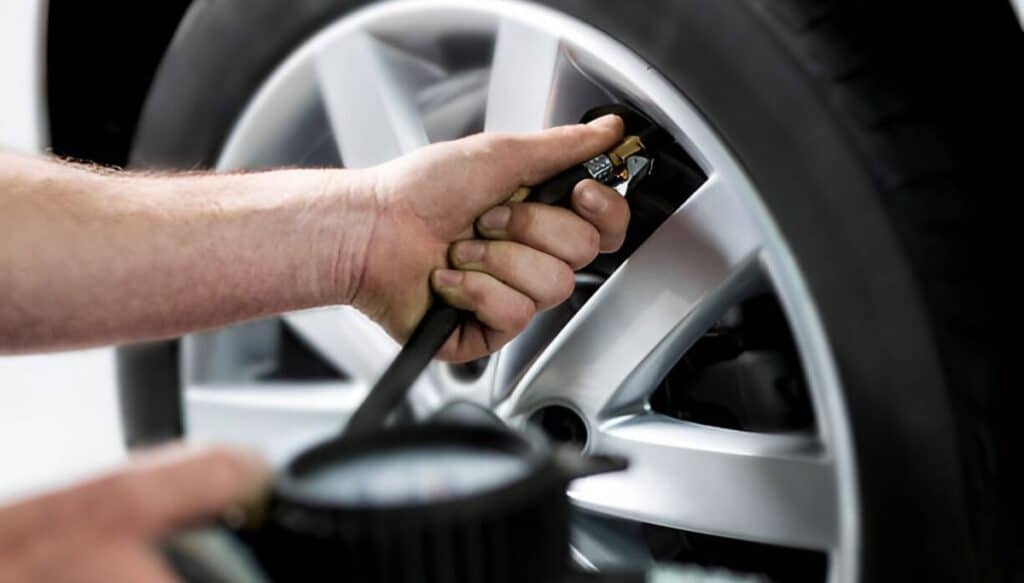
Keeping Your Car Tires at the Right Pressure
Finding the Ideal Air Pressure for Your Tires
Look for a sticker on your car’s door frame or in the owner’s manual. It shows the right tire pressure for your vehicle. Make sure your tires can handle the load listed on this sticker. You can find this info on the side of your tire.
Rotating and Balancing Your Tires
Switch your tires around every 5,000 to 7,500 miles. This helps them wear evenly. When you do this, also balance your tires. This spreads the weight equally on all four tires. Both these steps help keep your tire pressure steady.

Checking Your Tires for Problems
Look at your tires often. Check for holes, cracks, or bulges. These can make air leak out. Also, look for things stuck in the tire tread. Fixing these issues quickly can stop air from escaping.
To keep your tires in good shape:
- Check tire pressure weekly
- Use a good pressure gauge
- Check tires when they’re cold
When checking pressure:
- Wait 2 hours after driving
- Park in the shade
- Take off 2 psi if the car’s been in the sun
Choose the right gauge:
- Stick
- Digital
- Dial
Each type has pros and cons. Pick one that works best for you.
Remember:
- Every bit of pressure matters
- Even new gauges can be off by 3 psi
- This small difference is important for light cars
By following these steps, you’ll keep your tires at the right pressure. This helps your car run better and safer.
Why Your Tire Pressure Matters
Keeping your tires properly inflated is crucial for your safety and wallet. When you drive with the right air pressure, your car handles better and stays more stable on the road. This can help you avoid accidents and keep you safer behind the wheel.
Did you know that many flat tires could be stopped before they happen? By checking your tire pressure often, you can catch small leaks early and fix them. This simple habit can save you from being stuck on the roadside.
Your tires also need the right pressure to carry weight properly. If you’re planning a road trip with a full car, you’ll need to adjust your tire pressure. This ensures your vehicle can handle the extra load safely.
Want to make your tires last longer? Proper inflation is key. When your tires have too much or too little air, they wear out in odd patterns. This means you’ll need to replace them sooner, costing you more money.
Here’s a money-saving tip: check your tire pressure monthly. When your tires are underinflated, your car uses more gas. Even a small drop in pressure can increase your fuel use by 2-5%. That adds up over time!
To give you an idea of safe pressure levels:
| Car Type | Average PSI | Danger Zone |
| Light Passenger Car | 35 PSI | 28 PSI or lower |
As you can see, even a 7 PSI difference can put you in the danger zone. That’s why it’s so important to keep an eye on your tire pressure.
Many new cars come with tire pressure monitoring systems. These handy tools alert you when your tires need air. But don’t rely on them completely – it’s still good to check your tires yourself now and then.
By taking care of your tire pressure, you’re taking care of your safety, your car, and your budget. It’s a simple task that pays off in big ways.
Common Tire Air Loss Questions
Why is your tire deflating without a visible hole?
Tires can lose air even when you can’t see a hole. This might happen due to a few reasons:
- Valve stem issues: The small part where you add air might be leaking.
- Rim problems: The tire might not be sealed right against the wheel.
- Temperature changes: Cold weather can make tire pressure drop.
A tire shop can check these things for you. They have special tools to find small leaks. Keep an eye on your tire pressure regularly. This helps catch problems early.
How can you stop a tire from losing air?
If your tire keeps going flat, try these steps:
- Look closely at the tire. Can you see any nails or cuts?
- Check the valve stem. Is it tight? Does it have a cap?
- Clean where the tire meets the wheel. Sometimes dirt causes leaks.
If you can’t fix it yourself, a tire shop can help. They might:
- Patch small holes
- Replace the valve stem
- Reseal the tire to the wheel
Regular tire checks can prevent many air loss problems.

What causes tires to deflate quickly?
Tires can lose air fast for several reasons:
- Age: Old tires leak more easily.
- Small punctures: Even tiny holes let air out.
- Valve stem problems: These can let air escape.
- Weather changes: Cold snaps can lower tire pressure.
Here’s a quick guide to tire air loss speeds:
| Air Loss Speed | Possible Cause |
| Very Fast | Large puncture |
| Moderate | Small hole or bad valve |
| Slow | Natural seepage or temperature changes |
If you notice your tires losing air quickly, get them checked soon. Safe driving depends on proper tire inflation.
Remember to check your tire pressure often. This simple habit can save you from flat tires and keep you safer on the road.
Common Questions About car tire lose air
Why do car tires deflate overnight?
Tires can lose air quickly for several reasons. A small hole in the tire or a leaky valve stem often causes overnight air loss. Extreme temperature changes can also make tires lose pressure fast. Check your tires regularly to catch these issues early.
How can tires lose air without visible damage?
Tires can lose air even when you can’t see any holes. Tiny cracks in the rubber or a faulty valve stem can let air escape slowly. Wheel damage or a poor seal between the tire and rim can also cause invisible leaks. Use soapy water to find hidden leaks.
What makes one tire lose air in cold weather?
Cold weather affects tire pressure. Air contracts when it’s cold, lowering pressure inside the tire. This happens to all tires, but you might notice it more in one tire if it already has lower pressure. Check and adjust all tire pressures when temperatures drop.
What to check when tire pressure drops soon after inflation?
If your tire loses air right after filling it, look at these parts:
a. Tire sidewall and tread (for small punctures)
b. Valve stem (for damage or looseness)
c. Tire bead (where it meets the rim)
d. Wheel (for bends or cracks)
Why would a new tire lose air?
New tires can lose air due to:
- Poor installation
- Manufacturing defects
- Damage during shipping or mounting
- Faulty valve stems
If a new tire keeps losing air, take it back to the shop for inspection.
Is slow air loss in tires normal?
Yes, tires naturally lose some air over time. Most tires lose 1-3 PSI per month. This happens because air slowly seeps through the rubber. Regular pressure checks help maintain proper inflation. Fill your tires at least once a month to keep them at the right pressure.
